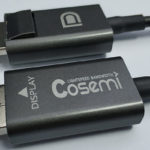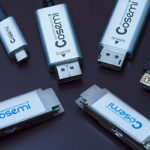Silicon Line evolved from an analog IC design house to a provider of innovative ultra-low power optical link technology which enables thin, light and long high-speed cables for mobile and consumer electronics markets. The company now has a wide portfolio of physical layer ICs plus associated SerDes ICs for multi-gigabit optical links and holds multiple patents associated with these products.

These components are used heavily in consumer markets for higher resolution images and video as well as high-speed data transfer to storage devices. The need for high resolution and high-speed data transfer is nothing new to the industrial, medical and security side, so this is a growing market for the company.
The company is headquartered in Munich, Germany and has offices in Korea, Japan, Taiwan, China as well as the US.
The development of several high speed cable standards such as DisplayPort, HDMI and USB 3.1 as well as new very slim connectors like USB Type-C which are needed for the latest slim form factor designs is requiring a change in the types of cables used to carry these high speeds. Conventional copper cables for these standards are thick, bulky, heavy and limited in length to 1 m or so depending on the data rate.
Low cost, low power, long, thin and light active optical cables are therefore replacing copper cables in these high-speed applications. Silicon Line is playing a key role in this process by making available both ICs and modules which allow quick and easy high volume manufacture of these new active optical cables.
I spoke with Silicon Line’s Ruud van der Linden, CEO and Ian Jackson, Director of Marketing, to learn more about the company and how it is changing the way devices are connected.
Mary: Thanks for being here with us Ian and Ruud. Can you give us a little history of Silicon Line and how you came to be?
Ruud van der Linden: Silicon Line was actually founded already in 2005 and so this not that young company. What we did over time, is that we are not only making the chips, but we also making the modules with our inter. We started doing that about three years ago. And why did we do that? One of the main reasons is that this technology was mainly used in let’s say data center and telecom. And bringing this technology to the consumer segment was very difficult because the cost of the solution in data center and telecom are far too high. Consumers are not going to pay $200 for a cable.
So what we did is we developed a technology in the modules which could significantly take the cost out of making the cable and also the cost of the module. And you talk about bringing those costs down with a factor of three to five at least. So you get cables that are more suitable for consumer pricing.
And we do it with a very low power. The advantage is, if you take a HDMI cable using our technology in optics you don’t need to power the cable.
So that’s a little bit of the expertise in Silicon Line. We were the first almost in the market for this optical part. And by the way, our ICs are so low powered that many professional applications are using our ICs also in the professional sector. And so you can see it used in security, where they use our technology for night vision. In medical, they use our technology in endoscopes. Also for machine vision and support. So it’s not that our starting point is consumer, we will see more and more that other segments are also interested because of the low power and the low cost version. So even now automotive is showing interest in using our technology, ’cause they need more bandwidth in the car.
We have a very small footprint. Our total optic lens can fit easy in a standard USB-C connector, which is very small already. You don’t need to enlarge the connectors by using our technology.
Mary Gannon: You have a strong voice in the fiber optic versus cable debate. What are your thoughts on that trend towards moving towards more fiber, and how the cable manufacturers have to change because copper was easier and less expensive?
Ruud van der Linden: You can always make copper work if you make it shorter and shorter and thicker and thicker. Those are the two things that need to be done for copper to still be in the game. That’s completely against the trend that people want longer and thinner cables because you don’t want the cable to be three times thicker than the TV. And it doesn’t fit in the connector anymore. So you see now also that for the first time, for example, in those standardization bodies, they cannot ignore optics anymore. Because they know that over certain lengths it doesn’t work anymore. So for the first time now in USB, in display ports, in HDMI, in forums you see that optics is a major discussion if it goes to the connectivity.
Ian Jackson: Now you see in the standardization bodies for HDMI I think we just mentioned HDMI 2.1 was released, and this is totally 48 gig, but each line is 12 gigabytes per second. And you look at USB that’s now 10 gigabytes per second, but USB-4 will be 20 gigabytes per second. And then you look at display ports, that’s now maximum 8.1 gigabytes per second.
And what you see is that this is all driven by higher resolution and higher frame rates, dynamic range, the high color contrast. And what you see is that for instance if you take a USB-3-gen-2 10 gig cable you can’t do more than about 60 cm, maybe 80 if you’re lucky with a copper cable. And even then it has to be quite big, quite fat and not very flexible.
This is just a limitation of how the data goes across a copper cable, it just, as the data rate goes up, as Ruud said, the cable gets thicker and shorter. And all of these industry standards are heading 20 gig and copper just can’t compete with that.
We are very active in the VR market space. So there is a new specification coming out called Virtual Link and this is where all the big guys in VR, Oculous, Microsoft, HDC, all the big guys are there and they make our standards and this is combining USB-3 and display port and power all in one cable. But they want high resolution, high frame rate, they want 5-m cable, 10-m cable and this just really not possible with a copper cable anymore. It just gets too heavy, too thick, too rigid. So we see that in this consumer space these industry standards are all pointing the way to optical cable technology.
Ruud van der Linden: So to come back to your question, the transformation is going on as we speak. We are all working on the next generation link, because they see that the cost of copper cable even if they could make something is getting much more expensive than doing optical cable.
The cable manufacturers have to adapt, so they are and we working with them. Ones who see this threat already and we work with them to learn how to make active optical cables with our technology. As we speak, we work with multiple companies, mainly in Asia, the big guys in copper, to transfer the next generation to active optical cables.
But many can’t do because they don’t have the technology in house, they don’t have the money in house. So they have to stick to the low end, and they will have a hard time to survive over time.
Ian Jackson: So what we do with our module technology is we make it very easy for those cable makers to make active optical cable. We supply the modules for both ends of the cable, so all the cable makers have to do is attach the bulk cable to the modules and put a connector and a housing and that’s the process they have to follow. And with our technology we make it a very simple assembly process for them, very fast, fully automated, very low cost so that they can hit the high volume and low cost which the consumer market needs.
Mary: There’s going to be a lot of big changes coming rapidly over the next two years. Very rapid change I’m sure.
Ian Jackson: Well you see, for example, in the Consumer Electronics Show in January, we were there at the HDMI forum booth, and we had a very nice demo with an 8K TV with the first HDMI-2.1 interface. So I think that was the only TV at the whole of CES which had a HDMI-2.1 interface. And they were using our prototype HDMI-2.1 active optical cable for that. And the reason was that there were some prototype copper cables available but they were very short. Sixty cms and very thick and fat so they wanted a longer distance and a very thin, flexible cable, so they had to go to the optical route for that. And that’s what we showed at CES in January.
And that will happen also with USB, USB-4, with display port-2, with the new virtual link standard in VR, it all goes to the same route.
Ruud van der Linden: So if you see any active optical cable in the market, like in HDMI and it has no external power, which is about 90%-plus, it is always using our solution.
Visit Silicon-line.com for more details on the company’s active optical cable modules.





Leave a Reply
You must be logged in to post a comment.